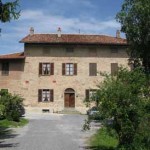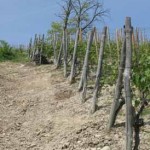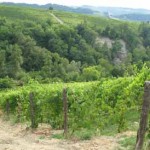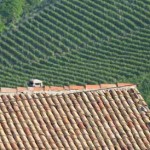The new generation: Barolo Fratelli Alessandria joins Berry Bros. and Rudd…
Author: David Berry Green
Week 12 of wine adventures in Piedmont
I’m very pleased to announce that Berry Bros. and Rudd is now working with the Fratelli Alessandria family of Verduno (see the video below), so complementing Berrys’ Barolo portfolio of Luciano Sandrone, Cantina Mascarello Bartolo, Giovanni Rosso, Marcarini, Giuseppe Mascarello.
Crowning the small hilltop village of Verduno, the  elegant 18th century Fratelli Alessandria cantina (left) produces approximately 5,000 cases from 14 hectares; including the crus of Monvigliero in Verduno and Gramolere in Monforte d’Alba. Their Barolo wines were recognised by King Carlo Alberto in 1843, identifying a notable quality that continues to be enhanced by the arrival of 5th generation Vittore, aside his uncle Alessandro and father Gian Battista. They are also proud producers of the Pelaverga wine, a charming and elegant pepper-scented thing from grapes grown almost in exclusivity around Verduno.
elegant 18th century Fratelli Alessandria cantina (left) produces approximately 5,000 cases from 14 hectares; including the crus of Monvigliero in Verduno and Gramolere in Monforte d’Alba. Their Barolo wines were recognised by King Carlo Alberto in 1843, identifying a notable quality that continues to be enhanced by the arrival of 5th generation Vittore, aside his uncle Alessandro and father Gian Battista. They are also proud producers of the Pelaverga wine, a charming and elegant pepper-scented thing from grapes grown almost in exclusivity around Verduno.
Vittore’s arrival in 2001, post commercial and oenological studies at Torino University, coincided with a period of positive change. ‘More attention to detail’ is how Vittore explains the improvements that have taken place over the past decade. No more so than in the vineyard, now a picture of health and source of bright fruit from appropriately low yields. 2001 was also the year that their single Monforte cru ‘Gramolere’ was released, echoing a regional trend. In the cantina new static stainless steel tanks, better temperature control, the addition of a few French 500 litre tonneaux, while persevering with 15/20 day wild yeast fermentations and 30 hectolitre botte (slavonian and French oak) ageing, have all combined to promote sales of bottled wine and thereby reducing their reliance upon sales to the bulk market; now down to approximately 15% of production.
Monvigliero (right) is Verduno’s and Alessandria’s standout site, first bottled  as such by the family in 1967 and more recently recognised in the recent classification of Barolo vineyards that now awaits Rome’s rubber stamp. The family own 1.3 hectares out of a total 20. Alessandria’s wedge faces plum south, on a near vertical slope, at between 250 – 320 metres, blessed with gleaming white calcareous soils and 30-year-old vines. Alessandria’s annual average production is a eye-watering 600 cases; invecchiamento kicks off in 20% tonneaux, before spending a further two years in 30 hectare litre botte. The wine is beautifully toned and perfumed, it’s relatively generous in a modern style yet profound, and sealed with a textbook taut lime-stony structure; a wine for up to 15-20 years ageing.
as such by the family in 1967 and more recently recognised in the recent classification of Barolo vineyards that now awaits Rome’s rubber stamp. The family own 1.3 hectares out of a total 20. Alessandria’s wedge faces plum south, on a near vertical slope, at between 250 – 320 metres, blessed with gleaming white calcareous soils and 30-year-old vines. Alessandria’s annual average production is a eye-watering 600 cases; invecchiamento kicks off in 20% tonneaux, before spending a further two years in 30 hectare litre botte. The wine is beautifully toned and perfumed, it’s relatively generous in a modern style yet profound, and sealed with a textbook taut lime-stony structure; a wine for up to 15-20 years ageing.
 Gramolere (left), their Monforte d’Alba vineyard, is a larger site at four hecatres out of a total 20, alongside those of Sandrone and Pira. Its elevation is higher than that of Monvigliero at approximately 425 metres above sea level, and it enjoys a particularly warm microclimate created by its altitude, tree sheltered location, a south-western aspect and by even steeper sandy clay soils. From 40-year-old vines, the Barolo is stylistically very different to Monvigliero; broader, denser, more mulberry than raspberry on the nose, the palate has a definite succulence, boasting velveteen tannins; so all in all a richer brew. But you may be wondering how a Monforte vineyard’s came to be in the hands of a Verduno estate: it’s all thanks to Vittore’s mother Flavia, nee Manzone. The cru was first bottled by the Alessandria family only in 2001, so an exciting new addition to the range.
Gramolere (left), their Monforte d’Alba vineyard, is a larger site at four hecatres out of a total 20, alongside those of Sandrone and Pira. Its elevation is higher than that of Monvigliero at approximately 425 metres above sea level, and it enjoys a particularly warm microclimate created by its altitude, tree sheltered location, a south-western aspect and by even steeper sandy clay soils. From 40-year-old vines, the Barolo is stylistically very different to Monvigliero; broader, denser, more mulberry than raspberry on the nose, the palate has a definite succulence, boasting velveteen tannins; so all in all a richer brew. But you may be wondering how a Monforte vineyard’s came to be in the hands of a Verduno estate: it’s all thanks to Vittore’s mother Flavia, nee Manzone. The cru was first bottled by the Alessandria family only in 2001, so an exciting new addition to the range.
On another tack, the finer, suppler quality of Barolo’s Nebbiolo tannins is what equally impressed Michael Garner, co-author of 1990’s guide to Barolo, back to write a piece for Decanter magazine on the region twenty years on (read it in the magazine’s forthcoming ‘Italy’ supplement). Not that he was able to secure a definite answer from any producer as to whether this welcome suaveness was due only to climate change, better vineyard practices/lower yields, or more gee-whizz in the winery; probably the sum of the parts as with all great wine….
For when Michael first started coming to the region on behalf of an embryonic  (and fairly radical) Oddbins in the mid ‘80s he told me that the group of then ‘revolutionaries’ (Clerico, Altare, Scavino, Rivetti, etc…), mostly outsiders looking to make good, presented a ‘constellation of stars among a murky sky of so-so traditionalists’. He regarded the ‘80s movement as an important step, shaking up the system and asking important questions of where Barolo was headed (or was that just the ‘80s?!) And now, twenty years on, he’s witnessing, as we all are, a return to the basics, to the roots, to a certain ‘conservatism’, even among those now ageing ‘militants’ as they buy large slavonian botte to tone down the oak (and micro-ox) influence…or perhaps it’s all just marketing! Whatever the real reason, he’s been so buoyed by what he’s tasted that he feels another book coming on!
(and fairly radical) Oddbins in the mid ‘80s he told me that the group of then ‘revolutionaries’ (Clerico, Altare, Scavino, Rivetti, etc…), mostly outsiders looking to make good, presented a ‘constellation of stars among a murky sky of so-so traditionalists’. He regarded the ‘80s movement as an important step, shaking up the system and asking important questions of where Barolo was headed (or was that just the ‘80s?!) And now, twenty years on, he’s witnessing, as we all are, a return to the basics, to the roots, to a certain ‘conservatism’, even among those now ageing ‘militants’ as they buy large slavonian botte to tone down the oak (and micro-ox) influence…or perhaps it’s all just marketing! Whatever the real reason, he’s been so buoyed by what he’s tasted that he feels another book coming on!
As a footnote, I concurred with Michael’s apposite comment that just as the gangly Nebbiolo bunch demands a long hang time to ripen, so surely it should follow that the fermentation and maceration period be equally long (30 days if you please) to gently extract the goodness from the skins, and the Barolo ageing or invecchiamento just as protracted (three-four years in oak, rather than the new two); thereby ensuring a long and fulsome life!
Next Week: Among the vines, it must be green harvest time; plus a visit to the royal hunting lodge La Venaria Reale as Italy empties to the coast
* ‘Barolo: Tar and Roses: A study of the wines of Alba’, Michael Garner and Paul Merritt, Random House


